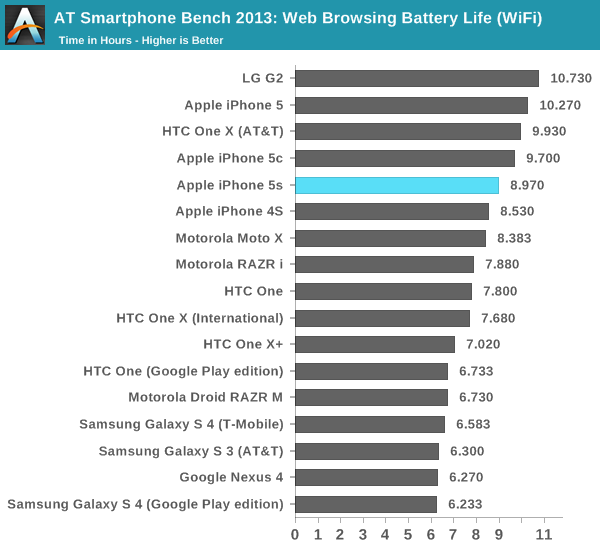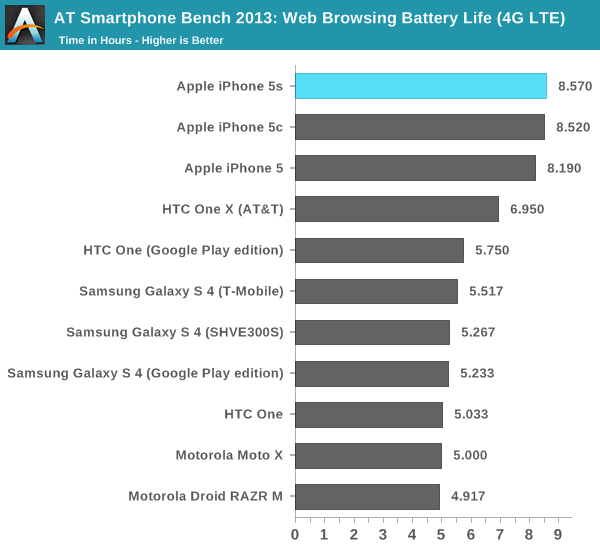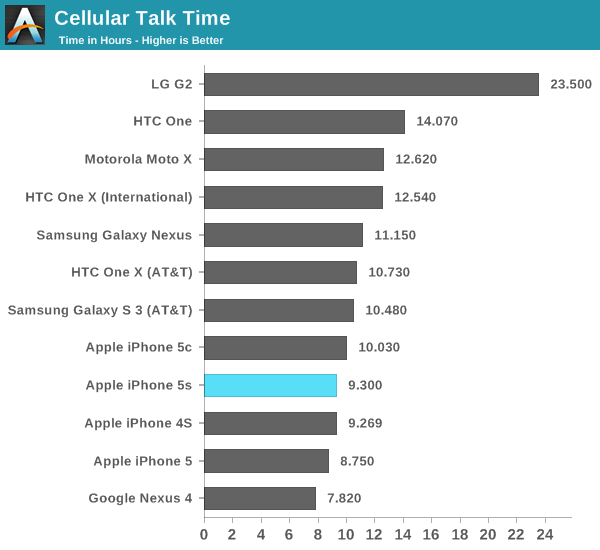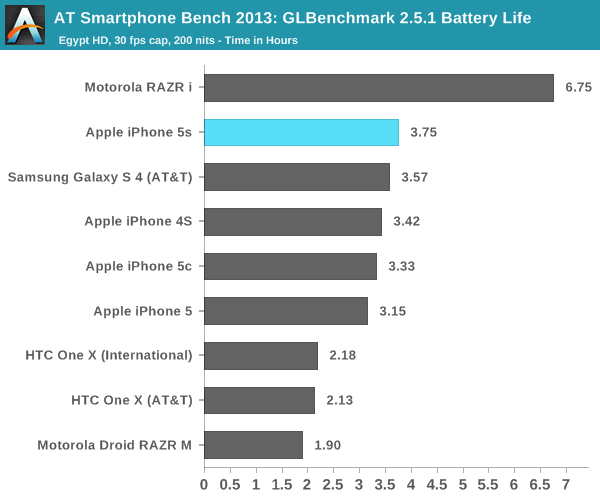The iPhone 5s Review
by Anand Lal Shimpi on September 17, 2013 9:01 PM EST- Posted in
- Smartphones
- Apple
- Mobile
- iPhone
- iPhone 5S
Battery Life
Brian did some excellent sleuthing and came across battery capacities for both the iPhone 5s and 5c in Apple’s FCC disclosures. The iPhone 5 had a 3.8V 5.45Wh battery, while the 5s boosts total capacity to 5.96Wh (an increase of 9.35%). The move to a 28nm process doesn’t come with all of the benefits of a full node shrink, and it’s likely not enough to completely offset the higher potential power draw of a much beefier SoC. Apple claims the same or better battery life on the 5s compared to the iPhone 5, in practice the answer is a bit more complicated.
Unlike previous designs, we’ve never had a half node shrink for an s-SKU. Both the iPhone 3GS and iPhone 4S stayed on the same process node as their predecessor and drove up performance. In the case of the 3GS, the performance gains outweighed their power cost, while in the case of the iPhone 4S we generally saw a regression.
The iPhone 5s improves power consumption by going to 28nm, but turns that savings into increased performance. The SoC also delivers a wider dynamic range of performance than we’ve ever seen from an Apple device. There’s as much CPU power here as the first 11-inch MacBook Air, and more GPU power than an iPad 4.
To find out the balance of power savings vs. additional performance I turned to our current battery life test suite, which we first introduced with the iPhone 5 review last year.
We'll start with our WiFi battery life test. As always, we regularly load web pages at a fixed interval until the battery dies (all displays are calibrated to 200 nits).

The iPhone 5s regresses a bit compared to the 5 in this test (~12% reduction despite the larger battery). We're loading web pages very aggressively here, likely keeping the A7 cores running at their most power hungry state. Even the 5c sees a bit of a regression compared to the 5, which makes me wonder if we're seeing some of the effects of an early iOS 7 release here.
The story on LTE is a bit different. Here we see a slight improvement in battery life compared to the iPhone 5, although the larger battery of the 5s doesn't seem to give it anything other than parity with the 5c:

Our cellular talk time test is almost entirely display and SoC independent, turning it mostly into a battery capacity test:

You can see the close grouping of the smaller iPhones at the bottom of the chart. There's a definite improvement in call time compared to the iPhone 5. We're finally up above iPhone 4S levels there.

Our Egypt HD based 3D battery life test gives us the first indication that Rogue, at least running fairly light code, can be more power efficient than the outgoing 5XT. Obviously the G6430 implemented here can run at fairly high performance levels, so I'm fully expecting peak power consumption to be worse but for more normal workloads there's no regression at all - a very good sign.










464 Comments
View All Comments
Srinij - Thursday, September 19, 2013 - link
We need to include the Xiaomi Mi3 when its out, its touted as the fastest.koruki - Thursday, September 19, 2013 - link
Some test show its slower than a Samsung S3Shadowmaster625 - Thursday, September 19, 2013 - link
Who wants to bet that we will see a 10x increase in the number of robberies that involve limb amputation over the next 5 years?dugbug - Thursday, September 19, 2013 - link
you think its easier to remove a finger from someone than threatening them to unlock their phone (which could be done with any pascode-based phone). Really. Jesus.koruki - Thursday, September 19, 2013 - link
I'll take that bet."But Apple promises that its reader can sense beyond the top layer of a user’s skin, and includes a “liveness” test that prevents even a severed finger from being used to access a stolen phone."
http://www.forbes.com/sites/andygreenberg/2013/09/...
hasseb64 - Thursday, September 19, 2013 - link
MEH, Iphone 5x main problems:-Small battery
-Screen to narrow, need 5mm width
Fix this Apple and you maight get a new deal here
nitemareglitch - Thursday, September 19, 2013 - link
Still my number one site for deep dives on hardware. As always, you do NOT disappoint. I am going to upgrade now! You convinced me. I am sold.av13 - Thursday, September 19, 2013 - link
Anand, thanks a lot. Having worked with IBM iSeries systems since 2000 - RS65 III or iStar and now Power systems I was stunned when techies and investors alike were shrugging off Apple's transition to 64 bit. The fact that the A7 is RISC based and 64 bit its performance is going to show in single threaded and multi-threaded apps. It was even funny when some experts quipped that the 5s has to have at least 4 GB for the 64 bit to make sense. I was very encouraged that at least Apple decided on this roadmap.Great analysis by you - as usual - Yawn!
petersterncan - Thursday, September 19, 2013 - link
I would really like to see how these phones stack up against the Blackberry Z10, Q10 and Z30.Are you considering reviewing those any time soon?
ScottMinnerd - Thursday, September 19, 2013 - link
Please excuse my ignorance, but can someone please explain how a JS-based benchmark is any indication of the quality of a CPU?There's so much abstraction between JS code and the CPU registers that you might as well benchmark the performances of a Ferarri vs. a school bus while they're driving over mattresses and broken glass respectively. On the same browser on the same operating system on the same motherboard using the same RAM and the same bus architecture, yes, JS code could give a relevant basis for comparison of CPUs.
Also, does the included iOS browser have a multi-threaded JS engine? Does the Android's?
If one were to run 4 or 8 instances of the benchmark test simultaneously, how would each instance perform on each device having each CPU? Would the metric be higher on the 4+ core devices?
If Apple is leveraging a multithreaded JS engine, or a 64-bit optimized JS engine (or both), then the quality of the CPUs depends upon a given workload. The workload on a phone in the real world is rarely solely JS-based. Testing the performance of JS and then implying that the iPhone (or its CPU) is superior in general is not only misleading, but toadying.